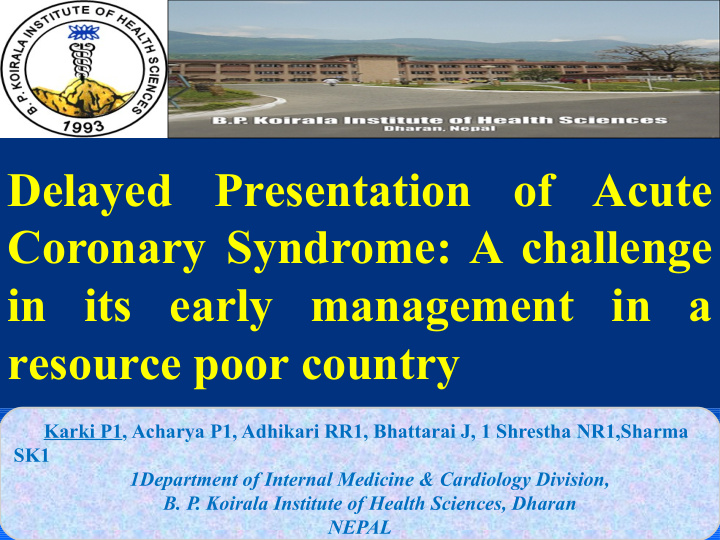



Delayed Presentation of Acute Coronary Syndrome: A challenge in its early management in a Click to edit Master subtitle style resource poor country Karki P1, Acharya P1, Adhikari RR1, Bhattarai J, 1 Shrestha NR1,Sharma SK1 1Department of Internal Medicine & Cardiology Division, B. P. Koirala Institute of Health Sciences, Dharan NEPAL
INTRODUCTION CVDs IN SOUTH –ASIA Ø High prevalence of risk factors & have IHD at an earlier age (one decades) than do the people in developed countries. Ø 80% deaths & 85% disability CVDs, Low & middle-income countries Ø CVDs – prevailing overall cause of mortality.
NEPAL Ø 27 million people, with vast ethnic diversity, Ø Nepal battling a Double Burden of Diseases, both communicable and non- communicable diseases (NCDs) Ø Cardiovascular diseases(CVDs) being the most common among the NCDs. Ø Epidemiological transition ,Urbanization & Changes in lifestyle .
• Hospital-based prevalence study of non communicable diseases in 31 hospitals across the country: Ø 36.5% of the admissions were for non communicable diseases, Ø CVDs were the most common (38% among NCDs Prevalence of Non-communicable Disease Nepal: Hospital- based Study. Nepal Health Research Council, 2010.
Ø Conventional risk factors are present in a high proportion in the Nepalese population Ø communicable & infectious diseases, maternal & child health Care & Childhood malnutrition Ø limited economy and resources, increasing problems of NCDs including CVDs.
BACKGROUND • The time of presentation of Acute Coronary Syndrome (ACS) from the onset of chest pain determines the treatment modality and prognosis. • Delayed presentation is associated with a poor outcome.
• Resource poor country like Nepal- Early diagnosis and proper management of ACS is delayed and continued challenging task: – Lack of awareness in patients. – Lack of suspicion of ACS in medical personnel at primary level. – Delayed referrals. – Lack of transportation facilities. – Financial burden.
OBJECTIVE To find out the causes of late presentation of Acute Coronary Syndrome (ACS) in tertiary care center in the Eastern part of Nepal.
METHODS • Cross sectional descriptive study. • Sample size-100 consecutive patients. • Center- BPKIHS, Nepal. • Duration- 8 months. • Included all patients of ACS. • Alternative diagnosis for chest pain were excluded. • Ethical clearance: taken from Institute Ethical Review Board. • Informed consent.
METHODS • Approved questionnaire filled in for each patient- included demographic and clinical parameters as well as delay in presentation and its cause in bringing the patient to our hospital • Management done at the local center & their final diagnosis. • Statistical analysis- Data were analyzed with SPSS 11.5 for Windows software.
RESULTS • Age ranged 36 to 84 years (mean 62 years, SD 10.4). • Eighteen patients ≤ 50 years of age. • Male : female - 1.6:1 Ø Symptoms: – Chest pain - 81% – Shortness of breath - 49%
Graph 1: geographical distribution of Patients.
• Time of presentation from the onset of symptoms to the healthcare facility: – 1- 360 hours (mean 32 hours). – 32 patients from Dharan city presented to our institute within mean of 20 hours. – 20 patients came to us directly from places outside Dharan within mean of 63 hours. – Others reached their respective local centers within mean 39 hours. – Males presented earlier (29 hours, mean value) than their female counterparts (39 hours, mean value).
Graph 2: causes of delay reaching BPKIHS
Table 1: comparison of different management done at health facilities before referring patients to BPKIHS Investigation District hospital Health Posts Private clinics done or (N=22) (N=3) (N=23) therapies given ECG 15 0 12 Cardiac Enzymes 0 0 1 Aspirin 14 2 9 Beta blockers 1 2 3 Nitrates 14 2 11 CCBs 0 0 1 Heparin/LMWH 0 0 0 Thrombolysis 0 0 0 Diagnosis of ACS 13 1 7 made
Table 2: distribution of ACS components and hemodynamic profile Diagnosis No. of SBP(SD) DBP(SD) Pulse(SD) Patients STEMI > 24 23 124(34) 86(21) 80(21) hours STEMI < 24 12 139(36) 92(24) 78(18) hours 24 130(35) 88(25) 91(24) Non STEMI Unstable 41 134(25) 85(17) 85(21) Angina
• Twenty three cases out of 35 STEMI i.e. 66% patients were not thrombolysed- late presentation. • Resulted in sub-optimal treatment.
DISCUSSION Tip of the Iceberg • Burden of CVD is large & on rise. • Younger population not spared: 18% patients ≤ 50 years (early age at presentation) • Smoking & Dyslipidemia major risk factors in premature CAD. • Addressing these risk factors – decrease complication of ACS.
Ø Transportation - leading cause of delayed presentation. • Patients brought to hospital via private vehicles/ambulances. • Ill-equipped vehicular transport.
Nepali Ambulances!!!!!!!!
Ø Lack of effective communication causes unnecessary delay- 2nd most common cause for delay. No communication between the healthcare staffs for transfer of patients. Ø Lack of ECGs at the primary care facility. No ECG machine Not suspecting ACS.
CONCLUSION § Strong need to pay attention to the rise of CAD & resulting ACS. § Significant number of patients with ACS presented late in our center & delayed presentation results in sub-optimal treatment & poor outcome. § Early diagnosis and effective treatment is the key reduce morbidity and mortality from ACS in Nepal
RECOMMENDATIONS
For a healthier Nepal………. Ø Improvement in ambulance services. Ø Equipping primary care facilities with ECG Ø Effective Communication Ø Greater emphasis on CAD awareness programs & initiating preventive measures.
Ø Larger community based study of CAD and its risk factors in Collaboration with International Organization. Ø Formulation of an New Health Policy & NCD policy draft , addressing all these issues.
HILLS FROM DHANKUTA DHARAN CITY
Recommend
More recommend